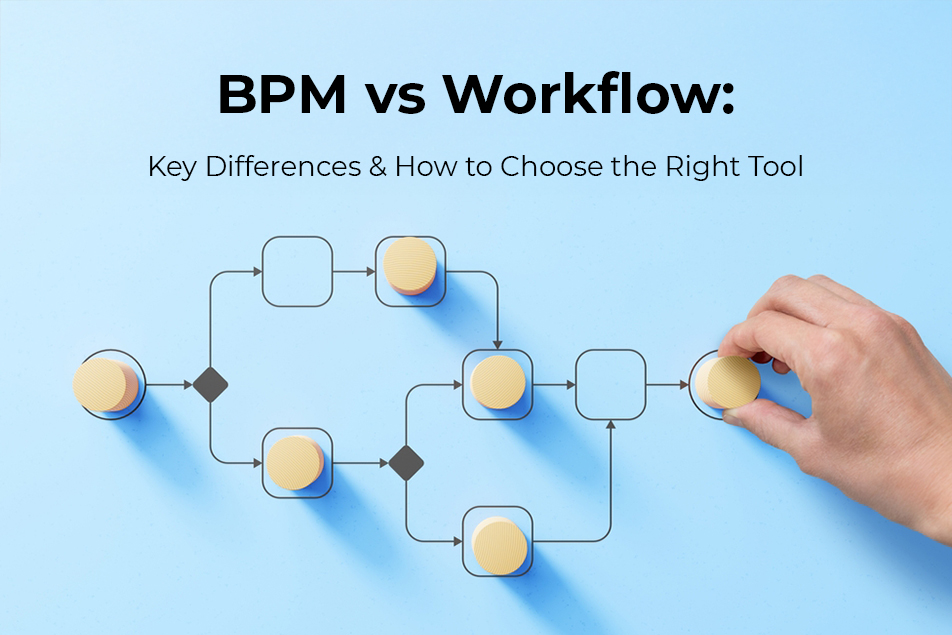BPM vs Workflow: Which Tool Should Your Business Choose and Why
Table of Contents
All organizations operate around a set of processes that are core to their business. However, this does not necessarily indicate that those processes are streamlined and well-connected. Inefficient workflows and processes can reduce productivity and hinder growth.
Organizations aiming to stay ahead of the competition in this digitally driven world should consider leveraging Business Process Management tools. Doing so will help transform complex business processes into streamlined workflows, which in turn improve process efficiency and enable stakeholders to make more informed data-driven decisions.
But isn’t business process management (BPM) and workflow management the same thing?
The workflow vs business process confusion is understandable. BPM and workflow management both share similar goals, and their end objective is to improve processes within an organization. They both leverage automation to a great degree. However, that’s where the similarities end. As core concepts, BPM and workflow have significant differences when it comes to choosing and applying each in your business.
If you’re looking to understand the two concepts closely and want to know when to use BPM versus workflow automation, continue to read further. In this article, we will explain both concepts clearly, illustrate them with real-world examples, highlight their differences, and show you how you can choose the right tool for your business.
What Is BPM and Workflow?
Let’s begin by defining the two terms.
Business process management (BPM) is both a technique and a technology. As a technique, BPM centers on identifying, studying, optimizing, and monitoring business processes so they deliver the desired outcomes and results. When leveraged as a technology, BPM can connect people, processes, digital workers, data, and systems.
A workflow, on the other hand, is a series of repeating steps that help complete a process. Workflow automation relies on automation and rules-based logic to automate these specific end-to-end tasks.
BPM supports organizations in optimizing workflows, overseeing, and automating the entire enterprise. Workflow automation is more focused on the individual processes and tasks that are included within the broader BPM system.
Despite their different approaches, BPM and workflows both aim to optimize, enhance, streamline, and make business processes more efficient. Let’s read on to know how the two can benefit your organization.
A Quick Look at the Benefits of BPM and Workflows
Prima facie, BPM and workflow have the same objective and help organizations:
- Save time
- Improve efficiency
- Reduce errors
- Save costs
- Boost productivity
If we look into it in greater detail, BPM enables organizations to get total visibility into their business operations. This tool can help managers get a better grip on the work across the organization, improve performance, predict outcomes, and constantly strive to get better results. Additionally, BPM also supports organizations in their quest to leverage automation to unify the workforce.
Workflow automation brings in a different set of advantages, such as better transparency to track progress, better use of employee abilities, improved customer experiences, and improved employee satisfaction as mundane, repetitive tasks are taken off their shoulders.
What Are Some Examples of BPM and Workflow?
If you’re still unsure of the distinction between BPM and workflow, looking at the two in action in the business world can be helpful. Let’s look at customer onboarding and how it is handled by each tool:
BPM Onboarding
BPM is considered to be the building block that organizations use to transform their operations. So, how does it work to improve an entire process, such as new customer onboarding?
In this situation, BPM helps redefine and streamline all the steps required for the successful completion of the onboarding process. BPM ensures all tasks, approvals, and documentation are completed on time and not held up due to bottlenecks in the process. This way, customers enjoy a seamless and efficient journey from the start to the end.
Workflow Onboarding
In the same scenario, workflow automation fulfills more specific roles. For example, the tool can be used to automate a specific section of the workflow, say, information retrieval. The workflow then focuses on that specific set of processes to improve the overall output. For ease of operations, it could look into other related processes as well, but not to the same level as BPM.
Let’s now look at how the two tools are different from each other.
BPM Vs Workflow: What Are the Key Differences?
Business Process Management and workflow management are interconnected approaches and yet there are differences between the two tools that organizations use to improve operational efficiency.
Purpose
BPM focuses on managing and improving business processes across the entire organization. When implemented, the tool can help align individual processes with the organization’s strategic goals, enhance the overall efficiency of the business, and ensure compliance with industry standards and regulations.
Workflow management, on the other hand, takes a closer look and helps refine specific tasks within a given process. Managers rely on it to streamline task execution, reduce errors, and boost productivity.
Complexity
BPM is tasked with managing complex, cross-functional processes that might include several departments, systems, and stakeholders. It relies on detailed analysis, design, and continuous monitoring to ensure processes are in alignment with business objectives.
On the flip side, workflow management deals with simpler, more linear task sequences within processes. The role of this tool is to manage routine tasks and ensure timely completion, without getting into the broader process complexities.
Implementation
BPM implementation requires a strategic approach that takes into account process analysis, design, modeling, execution, monitoring, and optimization. Organizations might be required to undertake significant organizational change to integrate BPM with their existing systems.
Workflow implementation is much faster and simpler. All that is needed here is to automate predefined tasks using workflow management tools or software.
Outcomes
When successfully implemented, BPM results in better operational efficiency, reduced costs, improved resource allocation, and enhanced customer service.
The outcome of workflow implementation is more straightforward. This solution focuses on specific tasks, deploying specific tools to streamline task execution.
Tools and Technology
BPM leverages tools such as advanced process modeling software, BPM suites (BPMS), process mining tools, and analytics platforms. These tools make it easier to conduct activities like process simulation, real-time monitoring, and dynamic process adjustments.
Workflow tools focus on specific tasks and task automation, and utilize project management software, task management tools, and simpler workflow engines that simplify task execution with their predefined parameters.
Making the Right Choice: Selecting Between BPM and Workflow Automation
The choice depends on what you wish to achieve and what your organization’s goals are. If the plan is to automate a single process within a team, then workflow will suffice.
However, if your visions are grander, opting for BPM might be a better idea. With this tool, you can optimize several processes within a single function, make swift improvements, and eventually roll out similar automation in other areas as well. BPM enables you to manage multiple workflows, forms, reports, and much more beyond that.
Run your requirements through these points to help guide your decision:
- Confirm your budget
- Define the scope of the project
- Identify the implementation area
- Determine the length of the project
- Ascertain whether the need is for one process or multiple interconnected processes
If you’re new to introducing these tools, you could consider implementing workflow automation as a test in one area. You can then bring in BPM once you gain better insights into the other processes you wish to transform.
How Are You Going to Improve Your Business Processes?
If you’re having trouble choosing, you don’t have to go with one or the other. Look for a platform that offers you the best of BPM capabilities while also providing the flexibility to transform complex processes into streamlined workflows. Find the right solution and you can get the best of both worlds.






